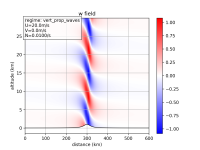johanneshorak
New member
em_hill2d_x - solution only stable when dampening layer starts at 5km
Hi all! This is the second question I have with regards to the idealized simulations I've been running (other thread here: https://forum.mmm.ucar.edu/phpBB3/viewtopic.php?f=46&t=8463 )
With the setup I use, I only find stable solutions (or at least something close too it, see the problem in the other thread) for the model top set at 25km, a dampening layer with 20 km thickness and a dampening coefficient of 0.1. The problem is that I would rather not dampen far into the part of the atmosphere that's relevant for my studies. Ideally I'd have an undampened field up to 15km, so the dampening layer should not start below that.
I've tested the parameter space quite extensively so far. Even setting the model top 5km higher and keeping everything else the same didn't result in the analytical queney solution. I've scanned through about 2000 combinations of these values but to no avail. The only setting that seems to be working is the one mentioned above.
The question therefore is rather general - how can I get this to work? And why does it seem necessary to start dampening that low already?
I've run the simulations with em_hill2d_x with a sounding derived from:
U = 20 m/s (constant with height)
N = 0.01 s**-1 (constant with height)
Θ = 270 K (at the surface)
P = 1013.25 hPa (at the surface)
RH=0%
Topography: Witch of Agnesi ridge
1000 m height, 20000 m half width at half maximum
Ridge is located at the center of the domain.
Please find attached:
WRF version used:
Hi all! This is the second question I have with regards to the idealized simulations I've been running (other thread here: https://forum.mmm.ucar.edu/phpBB3/viewtopic.php?f=46&t=8463 )
With the setup I use, I only find stable solutions (or at least something close too it, see the problem in the other thread) for the model top set at 25km, a dampening layer with 20 km thickness and a dampening coefficient of 0.1. The problem is that I would rather not dampen far into the part of the atmosphere that's relevant for my studies. Ideally I'd have an undampened field up to 15km, so the dampening layer should not start below that.
I've tested the parameter space quite extensively so far. Even setting the model top 5km higher and keeping everything else the same didn't result in the analytical queney solution. I've scanned through about 2000 combinations of these values but to no avail. The only setting that seems to be working is the one mentioned above.
The question therefore is rather general - how can I get this to work? And why does it seem necessary to start dampening that low already?
I've run the simulations with em_hill2d_x with a sounding derived from:
U = 20 m/s (constant with height)
N = 0.01 s**-1 (constant with height)
Θ = 270 K (at the surface)
P = 1013.25 hPa (at the surface)
RH=0%
Topography: Witch of Agnesi ridge
1000 m height, 20000 m half width at half maximum
Ridge is located at the center of the domain.
Please find attached:
- sounding
- namelist.input
- expected_analytical_solution.png - the solution that would be expected from linear mountain wave theory. (first attached plot)
- perturbed_w_field.png - showing the w-field of an "unstable" solution in units m/s. (second attached plot)
WRF version used:
Code:
commit d154456d9ca813b487872b7d685f6cc1da455e82
Merge: dd5c4c3 93e197c
Author: Ming Chen <chenming@ucar.edu>
Date: Mon Jun 3 17:18:32 2019 -0600
Finalize WRFV4.1.1 by merging bug fixes from release-v4.1.1 branch onto master.

